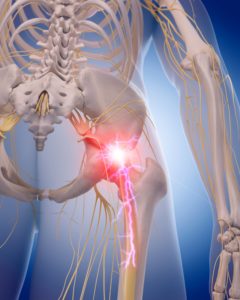August 23rd, 2018 by
Sciatica is a common condition that can knock you off your feet and be really disruptive to your everyday life. It causes a pain that can range from mild discomfort to absolute agony, but fortunately, it’s very treatable. If you’re worried about sciatica, read on for a complete guide to sciatica symptoms, causes, and how you can treat it.
What is Sciatica?
 Sciatica pain can be felt anywhere from your lower back down to your toes Sciatica is not actually a condition in and of itself; it’s a symptom that can be caused by a number of things. It occurs when the sciatic nerve – a nerve that stretches from your lower back down to your feet – gets irritated in some way. As this nerve irritation can be caused by different things, the symptoms of sciatica can be slightly different from person to person. Sciatica can occur in people of all ages, although it is much more common in people over 40.
Sciatica pain can be felt anywhere from your lower back down to your toes Sciatica is not actually a condition in and of itself; it’s a symptom that can be caused by a number of things. It occurs when the sciatic nerve – a nerve that stretches from your lower back down to your feet – gets irritated in some way. As this nerve irritation can be caused by different things, the symptoms of sciatica can be slightly different from person to person. Sciatica can occur in people of all ages, although it is much more common in people over 40.
What Can Cause Sciatica?
Sciatica can be caused by any number of things. It can be caused by relatively minor things like muscle strains which cause the muscle around the sciatic nerve to swell and put pressure on it. Sciatica can also be caused by spinal issues such as herniated discs, spinal stenosis, or fractures, which can cause spinal fluid to leak onto the nerve. It can also be brought on by tumours growing near the nerve, so be sure to see your doctor if your sciatica doesn’t go away. If you’ve had surgery or an internal injury to an area around the sciatic nerve, the scar tissue can also pinch the nerve. Sciatica is also common in pregnancy, where the weight of the growing baby can put pressure on the sciatic nerve.
What Are the Symptoms of Sciatica?
 Sciatica pain can come in many forms, so yours could be different to someone else's As sciatica has so many different causes, everyone experiences it in a slightly different way. Sciatica can occur as a numbness, a tingling feeling, or a stabbing pain, and it can be felt anywhere from your buttocks, down the back of your legs, or in your feet and toes. This discomfort can feel like anything from a cramp or a bruise to feeling like a broken leg in some cases. What this means is you could take two people suffering from sciatica and they could experience completely different symptoms. One person might complain of having pins and needles on the top of their foot, whereas the other might feel like they’ve been stabbed in the hamstring. This means if you’re noticing any kind of chronic pain or numbness in your buttocks, leg, or feet, it could be sciatica and you should get it looked at by a doctor.
Sciatica pain can come in many forms, so yours could be different to someone else's As sciatica has so many different causes, everyone experiences it in a slightly different way. Sciatica can occur as a numbness, a tingling feeling, or a stabbing pain, and it can be felt anywhere from your buttocks, down the back of your legs, or in your feet and toes. This discomfort can feel like anything from a cramp or a bruise to feeling like a broken leg in some cases. What this means is you could take two people suffering from sciatica and they could experience completely different symptoms. One person might complain of having pins and needles on the top of their foot, whereas the other might feel like they’ve been stabbed in the hamstring. This means if you’re noticing any kind of chronic pain or numbness in your buttocks, leg, or feet, it could be sciatica and you should get it looked at by a doctor.
How Long Does Sciatica Last?
Again, this can vary from person to person. Sciatica normally goes away in around four to six weeks, although it can last longer in some cases.
How Can I Treat Sciatica Pain?
 An electric heat pad gives you complete control over how much heat you apply to your body and are much safer than other heat packs You can ease sciatica pain in a number of ways which will also help speed up your recovery time. Gentle, low-impact exercises (like swimming or yoga) are always good to help your muscles stay limber and to increase circulation to the area. If you’re overweight this may also help you lose weight, which is another way to relieve sciatica pains as excess weight can put extra pressure on your sciatic nerve. Another great treatment for sciatica pain is to apply a heat pad to the affected area. This helps increase blood flow to the affected area and keeps you flexible. Try and avoid using hot water bottles as you have less control over how hot they are, and as one of the symptoms of sciatica is numbness, you might not be able to feel when your hot water bottle is too hot. Electric heat pads let you regulate their temperature and modern ones will shut down if they ever overheat, so you’re always kept protected. For severe sciatica that doesn’t go away, it may be that the underlying issue causing sciatica needs treatment from a doctor. This could range from steroid injections to physical therapy to surgery, but even if this is the case, you should still keep up your exercise and heat pad regime to help relieve some pain.
An electric heat pad gives you complete control over how much heat you apply to your body and are much safer than other heat packs You can ease sciatica pain in a number of ways which will also help speed up your recovery time. Gentle, low-impact exercises (like swimming or yoga) are always good to help your muscles stay limber and to increase circulation to the area. If you’re overweight this may also help you lose weight, which is another way to relieve sciatica pains as excess weight can put extra pressure on your sciatic nerve. Another great treatment for sciatica pain is to apply a heat pad to the affected area. This helps increase blood flow to the affected area and keeps you flexible. Try and avoid using hot water bottles as you have less control over how hot they are, and as one of the symptoms of sciatica is numbness, you might not be able to feel when your hot water bottle is too hot. Electric heat pads let you regulate their temperature and modern ones will shut down if they ever overheat, so you’re always kept protected. For severe sciatica that doesn’t go away, it may be that the underlying issue causing sciatica needs treatment from a doctor. This could range from steroid injections to physical therapy to surgery, but even if this is the case, you should still keep up your exercise and heat pad regime to help relieve some pain.
How Can I Stop Sciatica from Coming Back?
 Gentle exercise will help you to prevent Sciatica from returning The best thing you can do to prevent sciatica from returning is to make sure you stay active and exercise regularly. Go swimming, take up walking, and generally try to lead a normal, active life. This will also help you to stay at a healthy weight. Try and make sure you have a good posture, especially if your career sees you sitting at a computer all day. Don’t hunch over and make sure your office chair is comfortable to help keep your core muscles strong.
Gentle exercise will help you to prevent Sciatica from returning The best thing you can do to prevent sciatica from returning is to make sure you stay active and exercise regularly. Go swimming, take up walking, and generally try to lead a normal, active life. This will also help you to stay at a healthy weight. Try and make sure you have a good posture, especially if your career sees you sitting at a computer all day. Don’t hunch over and make sure your office chair is comfortable to help keep your core muscles strong.
When Does Sciatica Become an Emergency?
While sciatica can be excruciatingly painful at times, it usually isn’t an emergency and is very treatable with home remedies like heat pads and stretches. In rare cases, though, sciatica symptoms can be evidence of a severe back problem that may require emergency treatment. The NHS advises that if you have sciatica pains down both legs, or if your legs feel weak, you should visit A&E or dial 999. If you find it hard to go to the toilet, or if you can’t control needing the toilet in a way that isn’t normal for you, you should also seek emergency medical treatment.
Comments
Leave a reply
Your e-mail address will not be published. All fields are required


